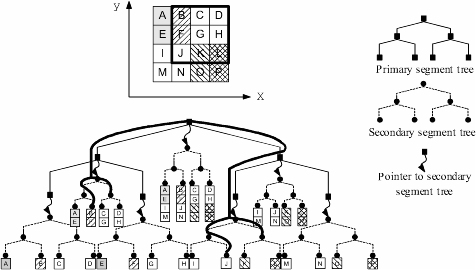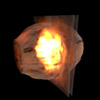- Real-Time Graphics |
- Rendering |
- Animation |
- Geometric Modeling |
- Scientific Visualization |
- Software System

- GPU-Assisted High Quality Particle Rendering

- Extending the Photon Mapping Method for Realistic Rendering of Hot Gaseous Fluids

- On Enhancing the Speed of Splatting Using Both Object- and Image-Space Coherence

- Rendering of Spherical Light Fields

- Indexing Data Structures for Faster Volume Rendering

GPU-Assisted High Quality Particle Rendering
Visualizing dynamic participating media in particle form by fully solving equations from the light transport theory is a computationally very expensive process. In this paper, we present a computational pipeline for particle volume rendering that is easily accelerated by the current GPU. To fully harness its massively parallel computing power, we transform input particles into a volumetric density field using a GPU-assisted, adaptive density estimation technique that iteratively adapts the smoothing length for local grid cells. Then, the volume data is visualized efficiently based on the volume photon mapping method where our GPU techniques further improve the rendering quality offered by previous implementations while performing rendering computation in acceptable time. It is demonstrated that high quality volume renderings can be easily produced from large particle datasets in time frames of a few seconds to less than a minute.
- D. Cha, S. Son, and I. Ihm, "GPU-Assisted High Quality Particle Rendering," Computer Graphics Forum (Eurographics Symposium on Rendering 2009), Vol. 28, No. 4, July 2009. (To appear)
- Comparisons of rendering images produced by uniform and adaptive smoothing lengths (Figure 1).
- Comparison of stochastic distance generation methods (Figure 2).
- Perlin noise in ray marching: Cloud2 (Figure 3).
- Rendering of Cloud1 (Figure 4).
- Rendering comparison: Smoke (Figure 5).
- Effects of different volume resolutions (Figure 6).
- [Experimental result: Cloud1]
- [Experimental result: Cloud2]
- [Experimental result: Smoke (particle data)]
- [Experimental result: Smoke]
- [Figure 2: Comparison of stochastic distance generation methods]
- [Figure 6: Rendering at multiple volume resolutions (Cloud2)]
- [Efficient jittering with Perlin noise on GPU (Cloud2)]
- [Cloud2 after composition]

With the increased sophistication and use of heated gas, fire, and explosion simulations in computer graphics applications, there is a corresponding impetus to improve the visual realism in the rendering of such simulated phenomena. In visualizing these turbulent fluids, an appropriate incorporation of their incandescent properties into the rendering significantly enhances the realism of visual effects. In this paper, we effectively synthesize the light emission phenomena of hot gaseous fluids by extending the photon mapping global illumination method. In particular we add two new photon maps to capture the thermal radiation effects. First, we define an emission photon map to store the photons emitted within hot gaseous fluids. Second, we utilize an additional flash photon map, which is very effective in creating a flash-like effect in explosions, visually capturing shock waves. Our current technique, while based on the theory of blackbody radiation, is parameterized to enable an animator to generate a wide range of visual effects with fairly intuitive user control. We demonstrate the effectiveness of our new rendering technique and user-controlled generation of visual effects with several example pictures and animations
- B. Kang, I. Ihm, and C. Bajaj, "Extending the Photon Mapping Method for Realistic Rendering of Hot Gaseous Fluids" Computer Animation and Virtual Worlds, October 2005.
- Generated animation scenes
- Adjustment of emission effect 1: Entire spectrum.
- Adjustment of emission effect 2:
- Adjustment of flash effect 1:
- Adjustment of flash effect 2: Before and after the application of the flash reflection photon map.
- Image samples obtained by varying the number of flash photons.
- The image Gone in a flash (Courtesy of NASA/JPL-Caltech/UMD).

Splatting is an object-order volume rendering algorithm that produces images of high quality, and several optimization techniques have been proposed. This paper presents new techniques that accelerate splatting algorithms by exploiting both object-space and image-space coherence. In particular, we propose two visibility test methods suitable for octree-based splatting. The first method, based on dynamic image-space range tree, offers an accurate occlusion test, and does not trade off image quality. The second one, based on image-space quadtree, uses an approximate occlusion test that is faster than the first algorithm is. Although the approximate visibility test may produce visual artifacts in rendering, the introduced error is usually found very little. Tests with several datasets of useful sizes and complexities showed considerable speedups with respect to the splatting algorithm, enhanced with octree only. Considering that they are very easy to implement, and need little additional memory, our techniques will be used as very effective splatting methods.
- R. Lee, and I. Ihm, "On Enhancing the Speed of Splatting Using Both Object- and Image-Space Coherence", Graphical Models, Vol. 62, No. 4, pp. 263-282, July 2000.
- An example of range tree.

- Octree nodes visited during splatting
[ON:Octree Only, OQ:Octree + Quadtree, OP:Orthographic Proj., PP: Perspective Proj.]
- Visual artifacts of the approximate visibility test
[Color map in (c) and (f): 0-white, 1-yellow, 2-green, 3-cyan, 4-blue,5-magenta, 6-red, 7-grey, greater than 8-black]

A plenoptic function is a parameterized function describing the flow of light in space, and has served as a key idea in building some of the recent image-based rendering systems. This paper presents a new representation scheme, called a spherical light field, of the plenoptic function, that is based on spheres. While methods using spherical coordinates are thought to require substantially more computation than those using planar or cylindrical coordinates, we show that spheres can also be used efficiently in representing and resampling the flow of light. Our image-based rendering algorithm is different from the previous systems, the light field and lumigraph, in that it is an "object-space" algorithm that can be easily embedded into the traditional polygonal rendering system. Our method is easily accelerated by 3D graphics boards that support the primitive functionality, such as viewing and smooth shading. In addition, we introduce an encoding scheme based on wavelets for compression of the huge data resulting from sampling of the spherical light field. As well as the proposed technique, that can be easily adapted to compress the light field and lumigraph data, offers as high compression ratios as the previous methods, it natuarally creates a multi-resolutional representation of the light flow that can be exploited effectively in the future applications. We show how to access the compressed data efficiently using a modified significance map and an incremental decoding technique, and report experimental results on several test data sets.
- I. Ihm, S. Park, and R. Lee, "Rendering of Spherical Light Fields", Pacific Graphics '97, pp.59-68, Seoul, Korea, October 1997

Splatting is an object-order volume rendering algorithm that produces images of high quality, and several optimization techniques have been proposed. This paper presents new techniques that accelerate splatting algorithms by exploiting both object-space and image-space coherence. In particular, we propose two visibility test methods suitable for octree-based splatting. The first method, based on dynamic image-space range tree, offers an accurate occlusion test, and does not trade off image quality. The second one, based on image-space quadtree, uses an approximate occlusion test that is faster than the first algorithm is. Although the approximate visibility test may produce visual artifacts in rendering, the introduced error is usually found very little. Tests with several datasets of useful sizes and complexities showed considerable speedups with respect to the splatting algorithm, enhanced with octree only. Considering that they are very easy to implement, and need little additional memory, our techniques will be used as very effective splatting methods.
- I. Ihm, and R. Lee, "Indexing Data Structures for Faster Volume Rendering," Computers & Graphics, Vol. 21. No. 4, pp. 497-506, July/August 1997
- I. Ihm, and R. Lee,"On Enhancing the Speed of Splatting with Indexing," IEEE Visualization '95, pp. 69-76, Atlanta, U.S.A., October 1995

_0001ph.jpg)
_0001ph.jpg)
_0001ph.jpg)







_cloud1(ASL3).jpg)





 = 0.3
= 0.3


 = (15.0, 700)
= (15.0, 700)

















